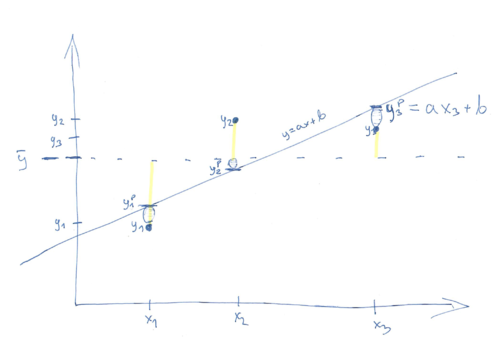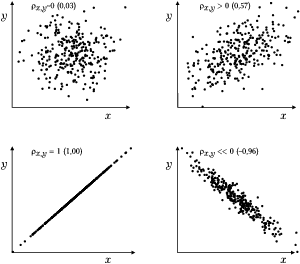
WnioskowanieStatystyczne/Interpretacja współczynnika korelacji: Różnice pomiędzy wersjami
| (Nie pokazano 9 pośrednich wersji utworzonych przez tego samego użytkownika) | |||
| Linia 28: | Linia 28: | ||
[https://en.wikipedia.org/wiki/Explained_sum_of_squares#Simple_derivation znika]). | [https://en.wikipedia.org/wiki/Explained_sum_of_squares#Simple_derivation znika]). | ||
| − | + | ===Współczynnik korelacji liniowej (Pearsona)=== | |
przypominamy wyprowadzone w poprzednim rozdziale zależności: | przypominamy wyprowadzone w poprzednim rozdziale zależności: | ||
| Linia 39: | Linia 39: | ||
</math> | </math> | ||
| − | oraz estymator współczynnika korelacji | + | |
| + | oraz wzór na estymator współczynnika korelacji liniowej | ||
| + | |||
<math> | <math> | ||
| − | + | r_{x, y}= \frac{\sigma_{x, y}}{\sigma_x \sigma_y}= | |
\frac{E\left( \left(x-\mu_{x})(y-\mu_{y}\right)\right)} | \frac{E\left( \left(x-\mu_{x})(y-\mu_{y}\right)\right)} | ||
{\sqrt{E\left( (x-\mu_{x})^2\right) E\left( (y-\mu_{y})^2\right)}}, | {\sqrt{E\left( (x-\mu_{x})^2\right) E\left( (y-\mu_{y})^2\right)}}, | ||
</math> | </math> | ||
| + | |||
jego kwadrat estymujemy jako | jego kwadrat estymujemy jako | ||
| + | |||
<math> | <math> | ||
| − | + | r^{2}=\frac{\left( \underset{i=1}{\overset{N}{\sum }}(x_{i}- | |
\overline{x})(y_{i}-\overline{y})\right) ^{2}}{\underset{i=1}{\overset{N}{ | \overline{x})(y_{i}-\overline{y})\right) ^{2}}{\underset{i=1}{\overset{N}{ | ||
\sum }}(x_{i}-\overline{x})^{2}\underset{i=1}{\overset{N}{\sum }}(y_{i}- | \sum }}(x_{i}-\overline{x})^{2}\underset{i=1}{\overset{N}{\sum }}(y_{i}- | ||
| Linia 57: | Linia 61: | ||
| − | + | Podstawiając | |
<math> | <math> | ||
\forall_i (y_i - \overline{y}) = | \forall_i (y_i - \overline{y}) = | ||
b (x_i - \overline{x} ) | b (x_i - \overline{x} ) | ||
| − | </math>, | + | </math>, oraz |
| + | <math> | ||
| + | b=\frac{\underset{i=1}{\overset{N}{\sum }}(x_{i}-\overline{x})(y_{i}- | ||
| + | \overline{y})}{\underset{i=1}{\overset{N}{\sum }}(x_{i}-\overline{x})^{2}} | ||
| + | </math> | ||
| + | |||
| + | |||
| + | do wyrażenia na wariancję tłumaczoną przez model | ||
| − | <math> | + | :<math>\underset{i=1}{\overset{N}{\sum }}(y_{i}^{p}-\overline{y})^{2} </math>, |
| − | \underset{i=1}{\overset{N}{\sum }}(y_{i}^{p}-\overline{y})^{2} | + | dostajemy: |
| − | </math> | ||
| − | |||
| − | |||
| − | |||
| − | <math> | + | :<math> |
| + | \underset{i=1}{\overset{N}{\sum }}(y_{i}^{p}-\overline{y})^{2} | ||
| + | = b \underset{i=1}{\overset{N}{\sum }}(x_{i}-\overline{x})^{2} | ||
=\frac{\left( | =\frac{\left( | ||
\underset{i=1}{\overset{N}{\sum }}(x_{i}-\overline{x})(y_{i}-\overline{y} | \underset{i=1}{\overset{N}{\sum }}(x_{i}-\overline{x})(y_{i}-\overline{y} | ||
)\right) ^{2}}{\left( \underset{i=1}{\overset{N}{\sum }}(x_{i}-\overline{x} | )\right) ^{2}}{\left( \underset{i=1}{\overset{N}{\sum }}(x_{i}-\overline{x} | ||
)^{2}\right) ^{2}}\underset{i=1}{\overset{N}{\sum }}(x_{i}-\overline{x} | )^{2}\right) ^{2}}\underset{i=1}{\overset{N}{\sum }}(x_{i}-\overline{x} | ||
| − | )^{2}= | + | )^{2}=\\ |
| − | |||
| − | |||
=\frac{\left( \underset{i=1}{\overset{N}{\sum }}(x_{i}-\overline{x} | =\frac{\left( \underset{i=1}{\overset{N}{\sum }}(x_{i}-\overline{x} | ||
)(y_{i}-\overline{y})\right) ^{2}}{\underset{i=1}{\overset{N}{\sum }}(x_{i}- | )(y_{i}-\overline{y})\right) ^{2}}{\underset{i=1}{\overset{N}{\sum }}(x_{i}- | ||
\overline{x})^{2}}\frac{\underset{i=1}{\overset{N}{\sum }}(y_{i}-\overline{y} | \overline{x})^{2}}\frac{\underset{i=1}{\overset{N}{\sum }}(y_{i}-\overline{y} | ||
| − | )^{2}}{\underset{i=1}{\overset{N}{\sum }}(y_{i}-\overline{y})^{2}}= | + | )^{2}}{\underset{i=1}{\overset{N}{\sum }}(y_{i}-\overline{y})^{2}}=r^{2} |
\underset{i=1}{\overset{N}{\sum }}(y_{i}-\overline{y})^{2} | \underset{i=1}{\overset{N}{\sum }}(y_{i}-\overline{y})^{2} | ||
</math> | </math> | ||
| + | |||
czyli | czyli | ||
| − | <math> | + | |
| − | { | + | :<math> |
| + | {r^{2}=\frac{\underset{i=1}{\overset{N}{\sum }}(y_{i}^{p}- | ||
\overline{y})^{2}}{\underset{i=1}{\overset{N}{\sum }}(y_{i}-\overline{y})^{2} | \overline{y})^{2}}{\underset{i=1}{\overset{N}{\sum }}(y_{i}-\overline{y})^{2} | ||
}\ } | }\ } | ||
Aktualna wersja na dzień 15:44, 5 maj 2024
Wnioskowanie_Statystyczne_-_wykład
Interpretacja współczynnika korelacji
Rozważmy wariancję zmiennej [math]y[/math] z poprzedniego rozdziału. Niech [math]y_{i}^{p}=a+bx_{i}[/math]
[math]
\underset{i=1}{\overset{N}{\sum }}(y_{i}-\overline{y})^{2}=
\underset{i=1}{\overset{N}{\sum }}(y_{i}-y_{i}^{p}+y_{i}^{p}-\overline{y}
)^{2}=
[/math]
[math]
\underset{i=1}{\overset{N}{\sum }}(y_{i}-y_{i}^{p})^{2}+\underset{i=1}{
\overset{N}{\sum }}(y_{i}^{p}-\overline{y})^{2}+2\underset{i=1}{\overset{N}{
\sum }}(y_{i}-y_{i}^{p})(y_{i}^{p}-\overline{y})
[/math]
Całkowitą wariancię zmiennej [math]y[/math] podzieliliśmy na dwa człony: wariancję estymaty [math]y_{i}^{p}[/math] wokół wartości średniej [math]\overline{y}[/math] i wariancję obserwowanych [math]y_{i}[/math] wokół estymaty [math]y_{i}^{p}[/math] (trzeci człon znika).
Współczynnik korelacji liniowej (Pearsona)
przypominamy wyprowadzone w poprzednim rozdziale zależności:
[math]
b=\frac{\underset{i=1}{\overset{N}{\sum }}(x_{i}-\overline{x})(y_{i}-
\overline{y})}{\underset{i=1}{\overset{N}{\sum }}(x_{i}-\overline{x})^{2}},
\qquad a=\overline{y}-b\overline{x}
[/math]
oraz wzór na estymator współczynnika korelacji liniowej
[math]
r_{x, y}= \frac{\sigma_{x, y}}{\sigma_x \sigma_y}=
\frac{E\left( \left(x-\mu_{x})(y-\mu_{y}\right)\right)}
{\sqrt{E\left( (x-\mu_{x})^2\right) E\left( (y-\mu_{y})^2\right)}},
[/math]
jego kwadrat estymujemy jako
[math]
r^{2}=\frac{\left( \underset{i=1}{\overset{N}{\sum }}(x_{i}-
\overline{x})(y_{i}-\overline{y})\right) ^{2}}{\underset{i=1}{\overset{N}{
\sum }}(x_{i}-\overline{x})^{2}\underset{i=1}{\overset{N}{\sum }}(y_{i}-
\overline{y})^{2}}
[/math]
Podstawiając
[math]
\forall_i (y_i - \overline{y}) =
b (x_i - \overline{x} )
[/math], oraz
[math]
b=\frac{\underset{i=1}{\overset{N}{\sum }}(x_{i}-\overline{x})(y_{i}-
\overline{y})}{\underset{i=1}{\overset{N}{\sum }}(x_{i}-\overline{x})^{2}}
[/math]
do wyrażenia na wariancję tłumaczoną przez model
- [math]\underset{i=1}{\overset{N}{\sum }}(y_{i}^{p}-\overline{y})^{2} [/math],
dostajemy:
- [math] \underset{i=1}{\overset{N}{\sum }}(y_{i}^{p}-\overline{y})^{2} = b \underset{i=1}{\overset{N}{\sum }}(x_{i}-\overline{x})^{2} =\frac{\left( \underset{i=1}{\overset{N}{\sum }}(x_{i}-\overline{x})(y_{i}-\overline{y} )\right) ^{2}}{\left( \underset{i=1}{\overset{N}{\sum }}(x_{i}-\overline{x} )^{2}\right) ^{2}}\underset{i=1}{\overset{N}{\sum }}(x_{i}-\overline{x} )^{2}=\\ =\frac{\left( \underset{i=1}{\overset{N}{\sum }}(x_{i}-\overline{x} )(y_{i}-\overline{y})\right) ^{2}}{\underset{i=1}{\overset{N}{\sum }}(x_{i}- \overline{x})^{2}}\frac{\underset{i=1}{\overset{N}{\sum }}(y_{i}-\overline{y} )^{2}}{\underset{i=1}{\overset{N}{\sum }}(y_{i}-\overline{y})^{2}}=r^{2} \underset{i=1}{\overset{N}{\sum }}(y_{i}-\overline{y})^{2} [/math]
czyli
- [math] {r^{2}=\frac{\underset{i=1}{\overset{N}{\sum }}(y_{i}^{p}- \overline{y})^{2}}{\underset{i=1}{\overset{N}{\sum }}(y_{i}-\overline{y})^{2} }\ } [/math]
przykłady interpretacji podaje też artykuł z Wikipedii

